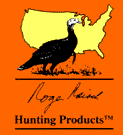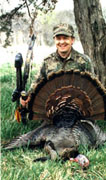Fall Behavior
Copyright © 1998 -
2021 Roger W. Raisch * Nadine Adele, all rights reserved
|
Fall is a time of
plenty and turkeys spend most of their time feeding.
Insects are available until a hard freeze occurs, and if a good mast crop was produced,
potential food items abound in the timber as well. Brood flocks retain their
integrity, but they may be found in virtually any habitat. Adult gobblers and
18-month old jakes stay together, while hens and their brood are together in their own
flocks. Fall flocks concentrate in good feeding areas and will stay there as long as
the food holds out, then they move to another spot. The SECRET to finding fall flocks is to find these good food sources.
|
As juvenile turkeys
get more confident, flock talk becomes more prevalent, particularly going to and coming
from the roost. Flocks leaving the roost in the morning
may produce a wide assortment of yelps, clucks, kee-kees and gobbles as they assemble. Morning is still the best time for turkey hunting, but early
rising isn't as essential as in the spring. Flocks leave telltale scratchings in the
timber after leaves fall in October. The noise made by a large feeding flock can be
audible for quite a distance, particularly if you know what to listen for. If all
else fails, young turkeys can often be induced to respond to a kee-kee even if the flock
isn't scattered.
|
The growing
independence of young turkeys becomes evident in late fall. Young
toms (jakes) begin feeling their oats and will harass each other and young hens.
Weak gobbles can be heard as they try out their new voices; strutting and short fights may
develop. In spite of this, however, one or more of the brood hens is in full control
of the flock. When scattered, the young birds are still
frantic to get back together and can be called rather easily with kee-kee or kee-kee-run
calls. Once the dominant hen begins clucking, cutting
or yelping, however, all the young birds will go immediately to her. By December
many jakes will have left or been expelled from the brood flocks. For the rest of
the winter they will travel together, or may temporarily join hen flocks or groups of old
gobblers.
|
Undisturbed fall
flocks move no more than a mile per day. Even those
that are flushed by hunters will move just a short distance before settling down
again. Since they can't be seen for more than a few yards and will remain silent for
a while after they have re-grouped, it may seem that all the turkeys have left the
county. Long distance movements are reserved for shifts to their winter feeding
areas.
|
As winter approaches and
food is depleted, flocks scratch more intently and may begin visiting crop fields to
supplement their diet. Insects
and weed seeds are less available in grassy areas and more of their time is spent in
sheltered timbers near crop fields. In areas where winters are severe, turkeys of
all ages and sexes may congregate at a favorable site and remain there until spring
arrives. Where crop fields aren't available, springs, seeps and areas with
berry-producing shrubs may winter smaller groups of birds. In the Midwest, winter
flocks of 50 to 60 birds are common, and flocks of 200 or more have been documented.
These are temporary feeding situations, however. Turkeys will break up as winter
moderates and the cycle begins again.
|
| |
|











